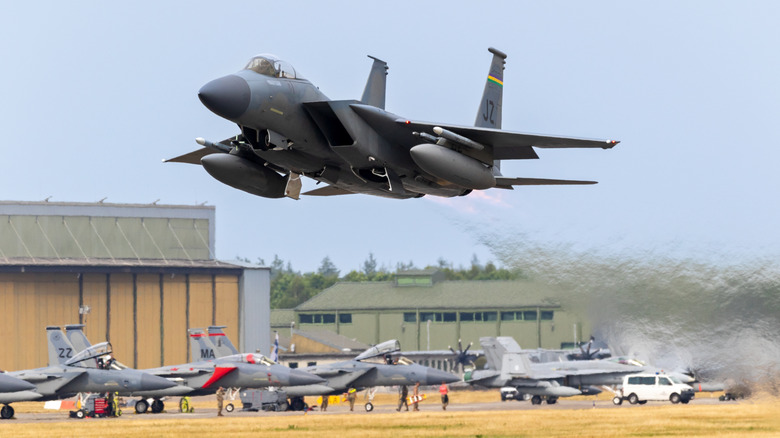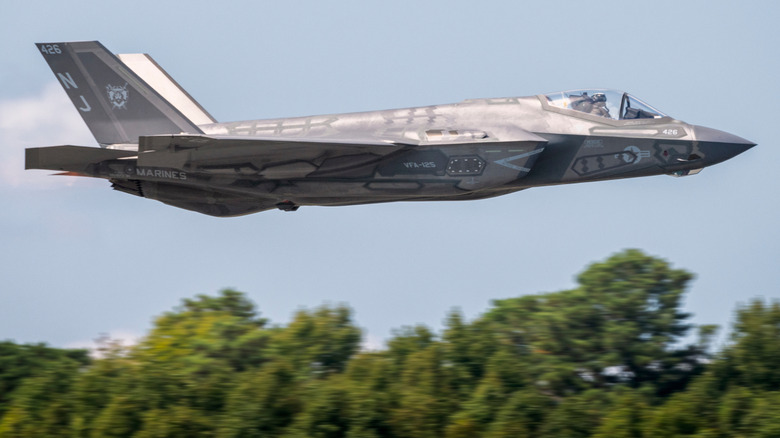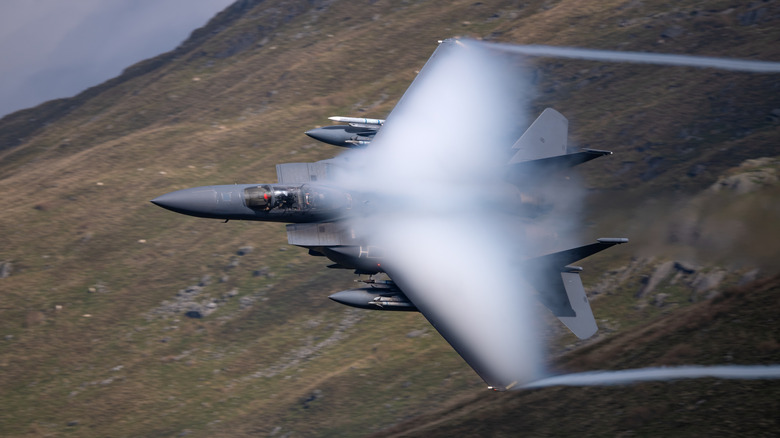Why Do Fighter Jets Fly So Low?
If you happen to live near an Air Force or Naval Aviation base, there's a good chance you've seen various aircraft flying overhead. You've probably also thought to yourself, "Why do those fighter jets fly so low?" It's a good question because it's a practice that somewhat defies expectations. In movies, you rarely see a fighter jet fly low to the ground, as they almost always come in from high altitudes to strike their targets and leave the same way they came in.
Military pilots do indeed operate at relatively low altitudes for a variety of purposes. During training, it's very common for aircraft to remain below 10,000 feet, where they operate at around 287.7 mph. This is considerably slower than fighter jets like the F-35A Lightning II, which can move up to 1,200 mph. With that said, observers won't just see jets flying low, as the T-6 Texan II is a leading military training aircraft that pilots use to learn the basics of flight.
Fighter jets also fly under 10,000 feet while undergoing training for specific mission types. And if we're talking about combat operations, it's not uncommon for a fighter jet to keep low to the ground to avoid enemy radar detection. That said, this isn't as necessary today as it was in the past due to advanced stealth technology and the way modern radar systems detect inbound threats. Here are all the reasons why fighter jets fly low to the ground.
Flying low during non-combat operations and training
In the past, the U.S. military generally operated in specific training areas. But as technology made jets faster and more agile, it became necessary to train over much larger areas. Today, this puts military aircraft in the same airspace as civilian aircraft, and occasionally, the results are disastrous. A deadly crash between a commercial jet and an Army UH-60 Black Hawk helicopter in January 2025 is evidence of how military and civilian air operations can clash.
Still, they continue, and it's not uncommon to see fighters and other aircraft operate at low altitudes near bases. The Air Force tends to do this often and reserves low-level airspace for the following types of training: instrument flights, which require training below 10,000 feet and a speed limit of 287.7 mph. The other is visual flight training, which flies at the same altitude, but at speeds exceeding 287.7 mph. Still, the Federal Aviation Administration prohibits them from veering within 500 feet of anyone or anything, be it a vessel, building, or vehicle.
The FAA works with the military to ensure everyone operates as safely as possible, but as mentioned previously, accidents can occur with low-flying aircraft. The U.S. military operates under the ideology that its forces "train as [they] fight," so if an upcoming mission requires low-altitude flying, training for that operation will include that type of maneuvering. This was depicted well in "Top Gun: Maverick," which had Naval Aviators train constantly at incredibly fast speeds and low altitudes to prepare for a mission.
Flying low during combat operations
Combat operations are significantly different from non-combat training ops for obvious reasons. If someone is flying into an area to bomb a target, the concern isn't going to be whether or not a fighter jet flies too low to the ground outside of standard safety concerns. The goal is to accomplish the mission and return home, and increasingly, fighter jets are flying lower to the ground during these operations. To maintain its pilots' capabilities in this area, the Air Force trains them to fly as low as 100 feet above the ground at high speeds.
This is so they can literally "fly under the radar," though that concept is a bit antiquated. During World War II, radars were limited and pointed higher off the ground, so you could fly beneath their detection zone. That's not always true these days, but it's still required training for Air Force pilots. Operating at high speeds and low altitudes can help to avoid ground missile radar systems, anti-aircraft artillery, surface-to-air missiles, and enemy fighters should they be sharing the airspace.
Fighter jets flying incredibly low to the ground is a common sight in the Ukraine-Russia War, where going too high is a good way to have an unfortunate encounter with an anti-aircraft missile. While modern radar systems can detect low-flying aircraft, many are still limited to a clear line of sight. Essentially, flying low reduces the effectiveness of a radar system, so it's likely military pilots will continue to fly low to the ground during many combat operations.


